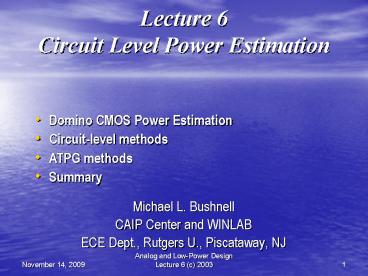Lecture 6 Circuit Level Power Estimation PowerPoint PPT Presentation
1 / 26
Title: Lecture 6 Circuit Level Power Estimation
1
Lecture 6Circuit Level Power Estimation
- Domino CMOS Power Estimation
- Circuit-level methods
- ATPG methods
- Summary
- Michael L. Bushnell
- CAIP Center and WINLAB
- ECE Dept., Rutgers U., Piscataway, NJ
2
Domino CMOS Power Estimation
- Ignore direct-path short-circuit currents
- Average power over all circuit nodes
- Normalized power dissipation measure
- fanouti is fanouts of node i
3
Domino Power Estimation
- F for n-type gate
- F for p-type gate
4
Results for Method on NAND
- Z static CMOS, PZ Domino internal node,
Z Domino output node
5
Circuit Reliability
- Signal activity is a good measure of
electro-migration and hot-electron degradation
(happens only in saturation) in circuits - Negative electro-migration leads to a hillock, or
metal build-up, that can short adjacent metal
lines - Hot electron injection into gate oxide layer
degrades gm and Vt, cumulative over time, limits
useful life of transistor - Mean time to failure (MTF) due to
electro-migration - Minimize electro-migration by minimizing
6
Circuit Reliability (contd)
- J Average Current Density
- K has statistical distribution, independent of J
- Hgate Agate fgate hot electron degradation, W
channel width, H and m
independent of transistor currents - T time that transistor has been operating
- Minimize reliability factor R to improve
reliability - R S Agate fgate activity x fanouts
7
Circuit-Level Power EstimationNeed to consider
capacitance at internal gate nodes to obtain more
accurate power estimate
8
Example CMOS Gate
X1
9
Signal Connections to Minimize Power
- Gate presents variable capacitance to power
ground, depending on logic inputs - If signal A has high activity and signal B has
low activity, then connect A to x2 and B to x1 to
minimize power
10
High-Level Power Estimation
- Method proposed by Landman and Rabaey for DSP
circuits - Stochastic modeling technique
- Uses relationship between bit-level probabilities
and word-level statistics - For speech, music, and images
- Least Significant Bits (LSBs) are uncorrelated in
space/time with P 0.5 and a 0.25 - Independent of data distribution
11
Word-Level Data Model
12
Most Significant Bit Data Models
- F1 bivariate normal distribution function
- F01 univariate normal distribution function
- r1 lag 1 correlation coefficient
- Breakpoint equations (where MSB correlation
starts)
13
Information Theoretic Approaches
- Estimate power at Register Transfer Level
- Estimate entropy and use it to find signal
activity - Entropy H (x) defined in terms of signal
probability p - For discrete-valued signal x, with n values
14
Activity Tracks Entropy
- Tracks entropy if temporal correlation can be
ignored - Theory not yet adequately developed
15
Maximum Power Estimation
- Can be important for desktop applications
- Design of power and ground lines
- Determining line voltage drop
- Determining packaging requirements
- Estimating maximum current to determine inductive
bounce in power supplies
16
Automatic Test Pattern Generation (ATPG)-Based
Method
- Dynamic current due to 2 consecutive binary
vectors - T (g) is binary variable showing whether gate g
switches - Method
- Sort all gates by output C in non-increasing
order - Assign transitions to gates from list with
largest output C or with the largest fanout - Used 9-valued D algorithm to justify transitions
with ATPG (automatic test-pattern generation)
program - Results more efficient and accurate than
simulation-based techniques for maximum power
estimation
17
Steepest Descent Method
- Approximate power as
- F (g) gate fanouts
- T (g) transition count at gate g output
- Method
- Use static timing analyzer to create time
sequences for given circuit - Propagate input time sequence in level order from
inputs through gates to circuit outputs
18
Problem Formulation
- Transform to continuous variable domain by
transforming Boolean operators into arithmetic
operators and by adding an unbiasing term to the
objective function
19
Steepest Descent Search Strategy
- Calculate gradient of objective (cost) function
at a starting point - Move along direction of gradient until objective
function starts to decrease, at which point we go
back to Step 1 - Stopping criterion
- Search reaches relative maximum point with 0
gradient - Search is stuck on hypercube boundary, with
gradient normal to the boundary - Avoid local maxima
- Choose different starting point
- Increase w (weight of non-biasing term in
objective function) to change shape of objective
function
20
ATPG vs. Gradient vs. Simulation Methods Unit
Delay Model
21
ATPG vs. Gradient vs. Simulation Methods Fanout
Delay Model
22
CPU Time Comparisons for Unit Delay Model Circuits
23
CPU Time Comparisons for Fanout Delay Model
Circuits
24
Comparison of Estimators
- Gradient optimization approach advantages
- Tighter lower bound for maximum power
- Much faster than simulation
- Can use complex gate delay models that ATPG
methods cannot use - Gets better max. power estimate than ATPG for 24
out of 40 circuits - Disadvantages
- Slower than ATPG approach
25
Genetic Algorithm Method
- Work of Hsiao, Rudnick, and Patel
- Genetic algorithm computes good local solutions
to power estimation, and then evolves and mutates
solutions to find even better solutions - Estimates good lower bounds of
- Maximum power per cycle
- Maximum sustained power under different delay
models - May be slow, so it may need parallel computers
26
Summary of Power Estimation
- Circuit-level and High-level power estimators
exist - Maximum power estimated with ATPG tools, using
steepest-descent gradient descent, or genetic
algorithms

